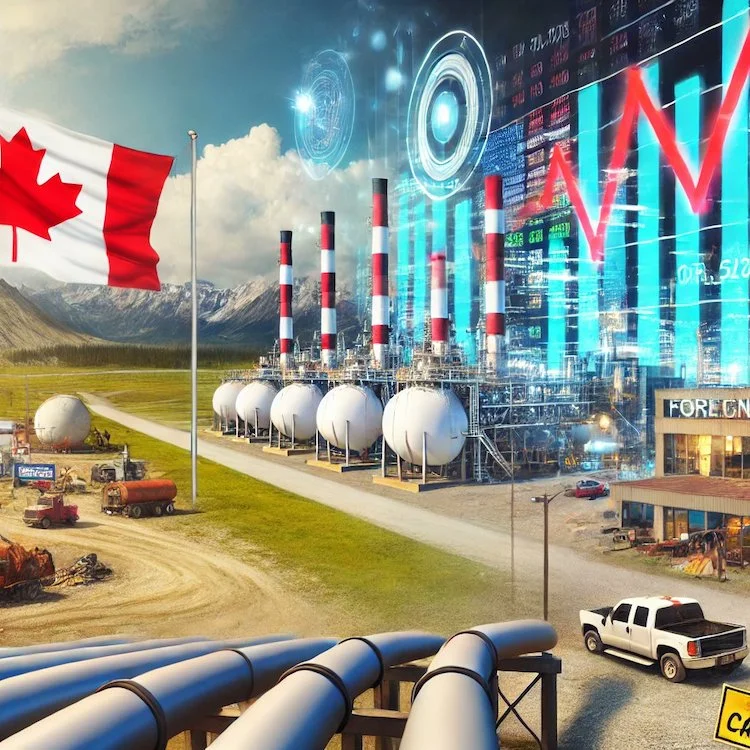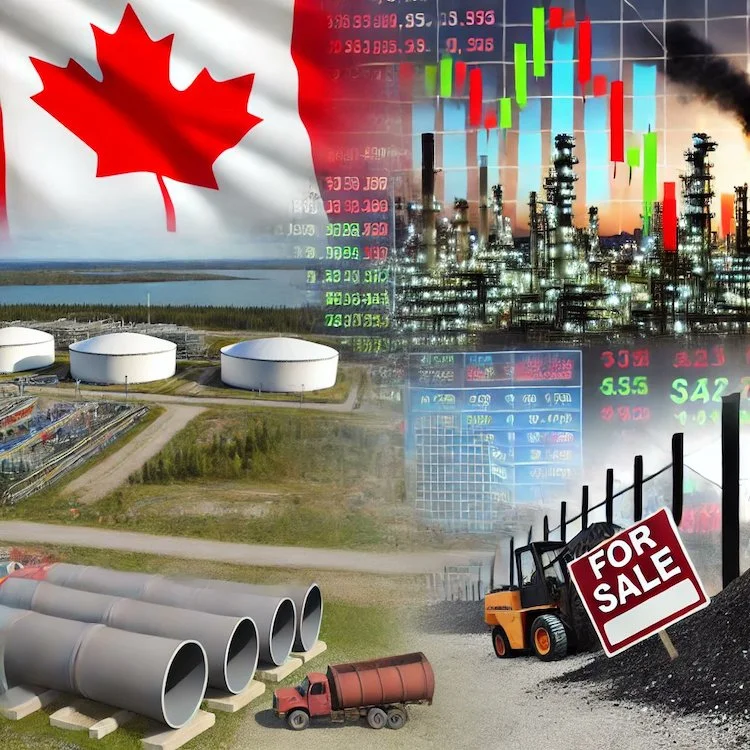Introduction
Canada has a significant number of resource and energy companies, reflecting its rich natural resources and substantial energy sector.
According to the latest data, Canada has over 2,150 for-profit companies in the energy sector. This includes a variety of industries such as oil and gas, mining, renewable energy, and utilities (Canadian Centre for Energy Information, PwC) (Energy Information Canada) (Energy Information Canada).
Energy Sector
-
Quantity of Companies: Over 2,150
-
Sources: Made in CA, Canadian Centre for Energy Information, Investopedia
-
Quantity of Companies: Over 1,700
-
Sources: Canadian Mining Journal
Combining the energy and mining sectors, Canada has over 3,850 companies in these industries, highlighting their extensive presence and significant impact on the national economy.
‘Should we block 3850 companies because we think this is the way to solve climate change, without talking to Engineers, Professional Technologists, Applied Science Technologists and Technicians of how it can be solved?’
‘Why should we ask politicians, administrative staff or everyday citizens how to solve it?’
These figures indicate the extensive presence and impact of resource and energy companies in Canada, underscoring their importance to the national economy.
Overview of Resource and Energy Companies (Revenues)
Oil and Gas Sector (examples):
Mining Sector (examples):
Impact of Policy and Regulatory Measures
The current federal administration, under the Liberal Party, has been in power for nine years (2015 to 2024). During this period, several policy and regulatory measures have been implemented, including:
Blocking Resource and Energy Projects:
Delays and cancellations of major pipeline projects. Restrictions on oil sands developments. Enhanced environmental assessments, leading to extended project timelines.
Foreign Direct Investment (FDI) Consequences
The restrictive policies have had a substantial impact on Foreign Direct Investment (FDI) in Canada’s resource and energy sectors.
Decline in FDI: Since 2010, there has been a notable decline in FDI in Canadian resource and energy sectors.
The uncertainty and regulatory burden have deterred foreign investors, redirecting global capital to more favourable international markets (Mordor Intelligence) (Canada).
Comparative Performance:While American energy stocks soared and their stock market reached new highs, Canadian markets did not see similar growth. Lack of innovation capital in Canada has stunted the growth and development of local markets and companies (Million Dollar Journey) (Clever Banker).
Impact on Innovation: The regulatory environment has stifled innovation in the Canadian energy sector. Companies faced challenges in securing funding for new technologies and projects, impacting long-term competitiveness.
Estimating the Economic Costs
Given the extensive contributions of the resource and energy sectors to the Canadian economy, the damage caused by these regulatory measures significantly exceeds the CAD 30 billion often cited. Here’s why:
Revenue and Employment Losses:The oil and gas sector alone had gross revenues of approximately CAD 174 billion in 2021
‘This does not include the dormant companies, the majority of the 2150 figure, which are dormant and ready to expand were they to gain capital inflow for development.’
Major companies like Cenovus, Suncor, and Imperial Oil collectively generate hundreds of billions in revenue annually.
Employment in these sectors is substantial, with over 179,200 workers in the oil and gas industry as of September 2023 (Investopedia) (Greenesa).
Investment Deterrence: The uncertainty and regulatory burden have deterred investments in new projects. Companies have postponed or cancelled capital projects, impacting future revenue streams and economic growth.
Long-Term Strategic Impacts:Canada’s competitiveness in the global energy market has been compromised. Potentially lucrative projects in renewable energy and critical minerals have faced delays.
Quantifying the Damage: Over nine years, the cumulative impact of lost revenue, reduced investments, and increased operational costs due to carbon taxes far exceeds CAD 30 billion.
Specific estimates suggest that annual revenue losses and additional costs might add up to tens of billions each year, considering the scale of the industry.
Stock Market Analysis: Canada vs. USA
The performance of Canadian stock markets compared to American markets highlights further economic impacts:
Growth Disparities: From 2010 to 2020, the Canadian TSX Composite Index grew by 23%, while the U.S. S&P 500 Index grew by 176%. The average annual returns were 2.1% for Canada and 10.7% for the U.S. (Million Dollar Journey) (Clever Banker).
Sector Concentration: The Canadian market is highly concentrated in financials, energy, and materials, whereas the U.S. market is more diversified with a significant focus on technology and healthcare.
Market Capitalization: The U.S. stock market’s total market capitalization is approximately $46 trillion, significantly larger than Canada’s $4 trillion (Clever Banker).
Foreign Investment: The Canadian market has higher foreign ownership due to its smaller size and concentration, making it more vulnerable to global market fluctuations.
Currency Impact: Fluctuations in the exchange rate between the Canadian Dollar and the U.S. Dollar can affect the value of stocks traded on the Canadian market, and with lowered export levels, there is less capital demand for CAD currency, lowering the value of CAD and increasing the prices of houses, food and all goods in the economy of Canada.
Conclusion
The financial impact of regulatory measures on Canada’s resource and energy sectors is profound and far underestimated at CAD 30 billion.
The comparative analysis of Canadian and American stock markets underscores the broader economic consequences, emphasizing the need for balanced policies that support both environmental goals and economic growth.
References
Note:
While this report aims to highlight important considerations regarding the economic impacts of certain policies on Canada’s resource and energy sectors, it is essential to acknowledge its limitations. The report does not:
-
Establish definitive causation: The report connects policy changes to economic outcomes but doesn’t conclusively prove direct causation. It doesn’t fully account for global market forces, pre-existing trends, or the impact of policies from previous governments. We don’t want to develop it further right now.
-
Provide a comprehensive economic analysis: The report lacks the depth and scope of a full economic impact assessment. It does not quantify the full ripple effects of policy decisions on related industries or offer a detailed cost-benefit analysis of alternative policy approaches. We don’t want to deepen the research level on this report, but merely present this data and source as we did not see it presented by MPs.
-
Represent all perspectives objectively: The report’s framing and language suggest a viewpoint from Conservative side of the perspective. We did not choose a neutral tone to be politically correct and to “appear objective”.
This report serves as a starting point for further discussion and a more in-depth analysis of the complex relationship between energy policy, economic growth, and environmental sustainability in Canada. Feel free to do a deeper, more granular, and better report with this seed knowledge, if you like.
Related Content:
Title: “Hello Laurel Collins, Since the NDP has selected you to be the ‘Critic for Environment and Climate Change,’ and given that this is the most critical debate in Canada for many years, it stands to reason that you are highly regarded within NDP circles.” https://x.com/SkillsGapTrain/status/1798982572594315305
Title: “To us, Canada’s housing inflation looks like an invention of the land supply policy makers, from the permitting administrators, from the citizen’s own political leaders.” https://x.com/SkillsGapTrain/status/1802393608672182369
Title: ‘Misguided Climate Policies or Strategic Economic Sabotage? Analyzing the Impact on Canada’s Economic and Environmental Future’ https://x.com/SkillsGapTrain/status/1799716240287571985
Title:“Building a Sustainable Future: Integrating Small Modular Reactors, Natural Gas, Hybrid Technologies and Reforestation for Climate Mitigation” https://x.com/SkillsGapTrain/status/1794987859868574173
Title: “Danielle Smith – “Natural gas plays a pivotal role in growing our economy and achieving our 🍃 emissions targets by providing a cleaner energy alternative.” https://x.com/SkillsGapTrain/status/1795250482237379010
Title: “Limits to Growth: A Global Food Crisis Looming on the Horizon and the Urgent Need for Decentralized Expansion of Independent Agricultural Producers in Canada, as a Path to Global Food Security and a High Standard of Living” https://x.com/SkillsGapTrain/status/1802082651278332362
Title: “Guardians of the Western World: The Alliance of Defense and Agriculture” https://x.com/SkillsGapTrain/status/1802701630455878102
Title:“Shadows and Shields: The Timeless Battle for National Prosperity” https://skillsgaptrainer.com/shadows-and-shields/
Title: “From Ceaușescu to Canada: Tracing the Transformation of Communism and the Rise of De-Growth and Centralized Control in Canada” https://x.com/SkillsGapTrain/status/1803164570153816204
Title: “Unleashing Canada’s Potential: Axing the Barriers to Land and Prosperity” https://x.com/SkillsGapTrain/status/1806452246068007323
Title:“Canada’s Hidden Frontier: 99.75%+ Untapped Potential and Unclaimed Wealth” https://x.com/SkillsGapTrain/status/1806429928914825379
Title: “The Great Filter Ahead: Engineering a Pathway to Complex Civilizational Survival and Overcoming Cosmic Hurdles” https://skillsgaptrainer.com/the-great-filter-ahead-engineering-a-pathway/
Title: “Pierre Poilievre’s Stand Against Carbon Taxation: Unveiling Canada’s Fight Against A Shift in Property Ownership and Investment” https://skillsgaptrainer.com/pierre-poilievres-stand-against-carbon-taxation/
Title:“Which is the country here that has 21st-century tech aspirations to build an advanced energy system, industrial system, and technology system? “https://x.com/SkillsGapTrain/status/1806803807885791618
Title: “From Shadows to Sunlight: The Canadian Rebirth and the Temple of Freedom” https://skillsgaptrainer.com/from-shadows-to-sunlight-the-canadian-rebirth/
Title: “Safeguarding Existence: The Farmer’s Role in an Era of Smart Cities and AI Dominance” https://skillsgaptrainer.com/safeguarding-existence-the-farmers-role/
Title: “Re-shoring the Future: Rediscovering the Value of Domestic Factories” https://skillsgaptrainer.com/reshoring-the-future/













‘Fix the broken countries of the west through increased transparency, design and professional skills. Support Skills Gap Trainer.’
To see our Donate Page, click https://skillsgaptrainer.com/donate
To see our YouTube Channel, click https://www.youtube.com/@skillsgaptrainer